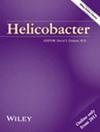Chronic Infection With Gastric Helicobacters Induces Hepatic Lesions in Mice
Abstract
Background
Helicobacter pylori infection is one of the most prevalent chronic bacterial infections worldwide. This bacillus colonizes the human stomach lifelong, where it induces chronic gastritis, evolving in some cases to gastro-duodenal ulcers, gastric adenocarcinoma, and mucosa-associated lymphoid tissue lymphoma. H. pylori infection has also been associated with extragastric diseases, and clinical data have suggested a role in liver pathogenesis. This retrospective study evaluated the consequences of chronic infection with gastric Helicobacters on liver pathogenesis in a mouse experimental model.
Materials and Methods
C57BL6 mice were infected with either H. felis (n = 12) or five human and mouse-adapted strains of H. pylori (n = 77) for one year. Uninfected mice were used as negative controls (n = 10). Histopathological analysis of paraffin-embedded liver tissue sections was performed, and scores were determined in a double-blind manner for inflammation and steatosis.
Results
Mice infected with H. felis and several H. pylori strains developed more liver parenchymal inflammation and steatosis, known precursor lesions of liver carcinogenesis, compared to non-infected mice. The presence of liver lesions was positively correlated with the detection of lesions of the gastric mucosa, more particularly gastric inflammation and metaplasia.
Conclusion
Chronic infection of mice with H. felis and H. pylori induces liver pathogenesis characterized by parenchymal inflammation and steatosis, which may be associated with the severity of gastric histopathological lesions. Understanding H. pylori infection's impact on extragastric lesions could in fine help detect and prevent the emergence of other digestive tract-related diseases.


 求助内容:
求助内容: 应助结果提醒方式:
应助结果提醒方式:


